Last Updated on August 6, 2019 by Dean Anderson
The humble tent stake is an overlooked, frequently forgotten and often lost piece of camping gear.
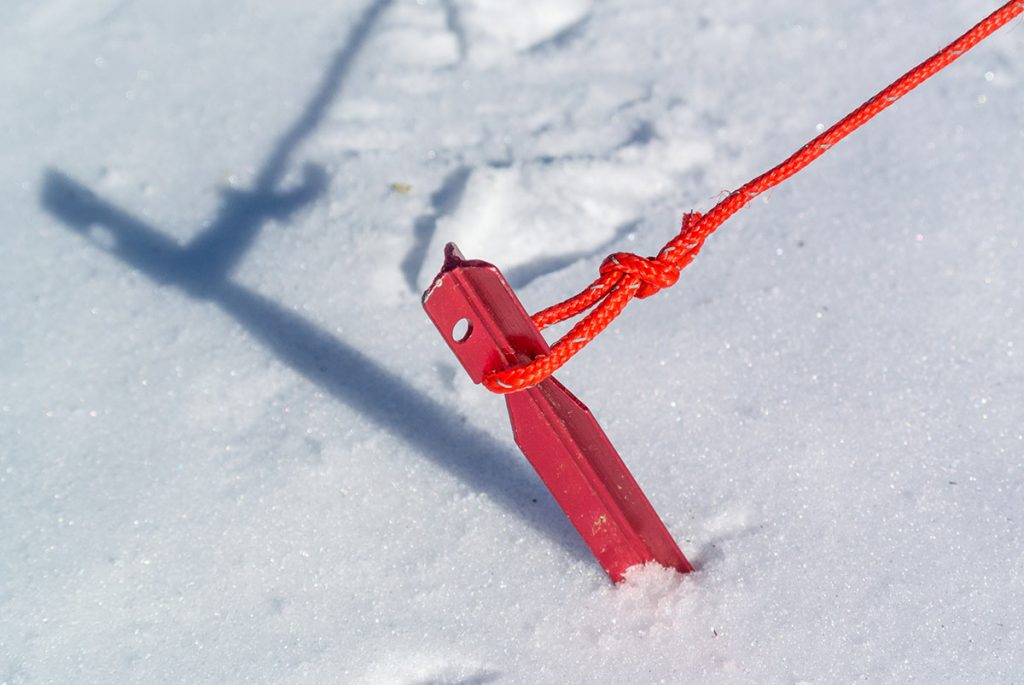
The tent pegs you get bundled with your tent are generally cheap and nasty pieces of metal that bend all too easy and are almost invisible in the grass. Thankfully there are many after market options available that will suit camping in different conditions and geographies.
I remember receiving some lightweight aluminum MSR stakes as a gift and was totally made up. These were awesome for swapping out with the stainless steel pegs I had in my backpack. From then on I’ve acquired lots of different types and brands so that I can camp in most environments, whether backpacking or car camping.
Inserting tent pegs the correct way
It’s amazing how many people don’t actually know how to set tent stakes into the ground.
I see people on our campground clobbering their stakes with rocks and hammers 90 degree’s into the ground. This can result in guy lines coming undone, damage to the stake or damage to you!
Instead do this;
- Hold the stake with the top leaning away from the tent, a 45-60 degree angle works well
- Apply even pressure using the toe of your shoe to push the stake into the ground. Don’t do this with bear feet or flip-flops, if you hit a rock you’ll know about it
- If the stake won’t drive in fully to the head then try moving it a few inches either side
Of course if you’re camping in snow then you may want to use the ‘dead mans’ position with the anchor laid horizontally and then buried in the snow. You can use a similar technique in sand.
Tent Stake Material
The material the peg is made from dictates what kind of camping it can be used for. The best tent stakes are light, strong, durable and highly visible.
Here are the common materials used to make camping stakes.
Metal Alloy
This is the material most cheap and cheerful camping stakes are made from. They’re light but bend easy and are easily lost. When you need to replace them be sure to upgrade with any of the options below.
Steel
Steel tent pegs vary in quality. We’re focusing on the better quality galvanized stakes. They’re heavy but super strong and durable.
Aluminum
Aluminum is one of the most abundant metals in the earths crust. It therefore makes perfect sense to make products from it that need to be light yet strong, bike frames, cars and of course, tent pegs. The abundance also makes it relatively cheap.
Titanium
Titanium tent stakes combine the strength of steel with the weight advantages of aluminum. Given the rarity of the material you should expect to pay a little more for titanium made products.
Plastic
Plastic stakes are cheap and light and furthermore can be made in bright fluorescent colors so that they’re easy to see in the ground. The downside is that these aren’t so durable and can easily snap.
Carbon
While carbon isn’t as inherently strong as aluminum or steel it is very light. Manufacturers like MSR have used carbon in the core of some of their products and encased with aluminum to result in a strong and light tent stake. Great for backpacking in the back country where weight matters. The only downside is they can be a bit of pricey option.
Visibility
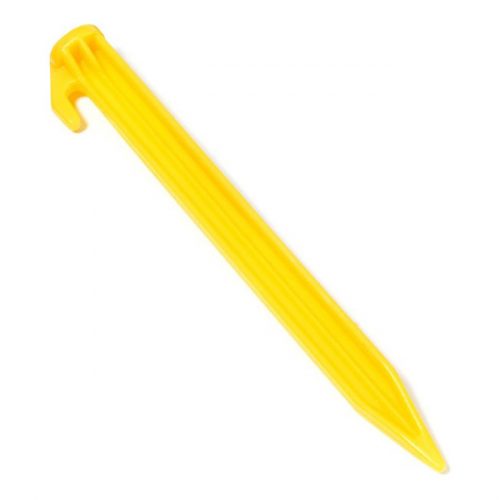
At the end of every weeks camping at our campground I can literally fill a bag with the tent stakes that are left behind. This is mostly accidental and most are the cheap metal wire stakes. They’re often difficult to spot in the ground once you’ve taken your tent down. Furthermore many have been hammered too far into the ground to pull out.
The more visible options are safer. They get accidentally kicked less, avoiding injury and they don’t litter our great outdoors quite as much.
Size and Length
Longer stakes will give you more of an anchor point. Tents held down with longer pegs will take more of a battering from the elements. Of course they’ll also weigh more and take up more room in your car or backpack. You’ll need to decide if that’s an issue or not.
Best For Soft Ground
Most of the camping you do will likely be in a temperate environment in which case the ground will be relatively soft. Reasonably light and strong stakes should suffice.
MSR Ground Hog Stakes
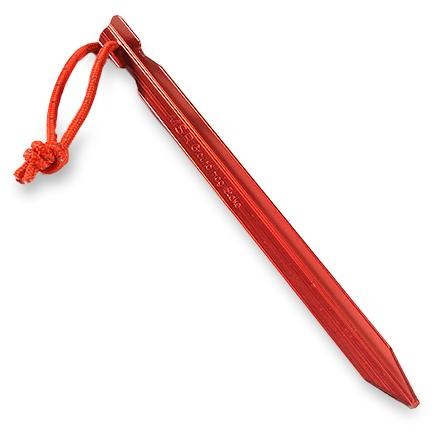
Ground Hogs are my personal go to stakes for many ground conditions and for securing both my backpacking tent and my four man.
They’re made of Easton Aluminum making them light and strong. Plus at 7.5 inches long they weigh only 0.5 ounces. Of course there are lighter pegs available but these offer a good mixture of weight to strength and price performance. If you are a weight freak then there’s always the mini (shorter) version of the same product.
The three sided design gives the stake a large surface area which means they stay put. When required though you can easily pull them out with the attached loop of nylon pull-cord.
The red anodised finish also makes them easy to spot in the ground. Kicking a tent peg isn’t much fun.
I’d really like to give a negative to balance out this brief review but I just can’t think of any. Although I wouldn’t use with a rubber mallet if that helps, it will come off worse!
Having used them for well over 4 years they’re an excellent product and a good upgrade for most tents.
Check the latest price on REI.com
Best Tent Stakes For Hard Ground, Rock or Ice
For these conditions strength is paramount. You’ll also need to be able to drive the tent peg in with a hammer. For these conditions we recommend nail style tent stakes.
Coleman 10in Steel Nail Tent Pegs
These long tent stakes from Coleman are made from galvanized steel. With a decent hammer they’ll drive into just about any stony or hard-packed ground.
They make a real upgrade over the cheap allow pegs to securely anchor your family tent to the ground.
The green polypropylene tops are fairly robust. However if you do continually drive the whole of the stake into the ground then pull on these to get the stakes out they will eventually break. Instead set the stakes three quarters into the ground maximum and when pulling use a vice or set of pliers to pull. They’ll last way longer.
For car camping these are an all round good option but their weight means they’re not the best option for backpacking.
Tent Stakes For Sand, Snow and Loose Material
If you enjoy camping in winter or on higher ground then you should probably own some decent stakes for snow.
REI Co-op Snow Stake

These really long and broad stakes from REI are clearly for use in snow or sand. The concave shape hugs the ground and the holes along the length allow snow or sand to pass through to further secure the stake. They’ve got great holding power.
The stand out orange color also makes them bright and easy to find in the white stuff. If you wish you can also bury the peg in a dead mans position or even upside down so that the lip provides further traction.
In that instance you would use one of the holes to tie your guy line to.
At 1 ounce these are light for the size but not in the same league weight wise as the Groundhogs or carbon offerings.
One other good thing the REI Snow Stakes are good for is digging catholes. Give it a go and it might save you taking a backpackers trowel to dispose of your waste.
Check the latest price on REI.com
Best Tent Stakes For Backpacking
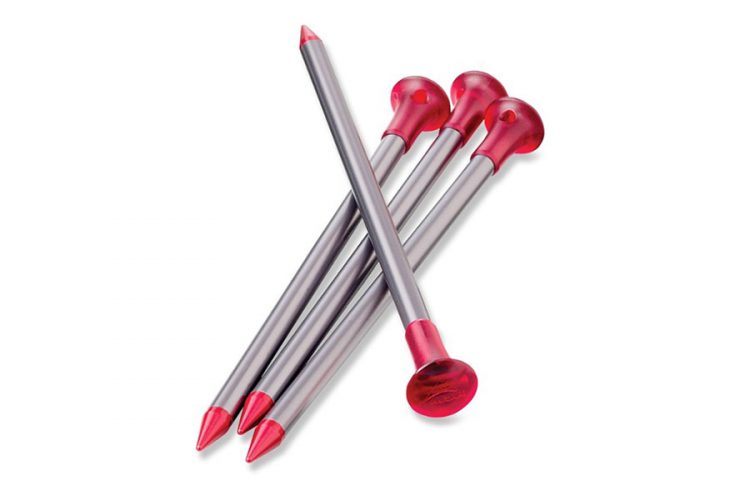
If ever a set of tent stakes deserved an award for their design it’s these beauties. Put them side by side any others and they look simply stunning.
But do they perform?
Well the brief for these was to create a light yet strong tent peg for backpackers. The result is a carbon core stake with aluminium outer and tip that makes them supremely light at only 0.2 ounce each. You’ll barely notice them in your backpack.
And yes they’re relatively strong but they’re not as versatile as many cheaper offerings on the market. Furthermore I wouldn’t use them on anything else but soft ground that you’re familiar with. Don’t let them get anywhere near rocks!
These are an extravagance, but a gorgeous one at that. Still I wouldn’t fancy losing one given the price.
Check out the MSR Carbon Core Tent Stakes
Rounding things up
If you’re a frequent camper or backpacker it’s vital you have a few stakes to cope with all weather and ground conditions. If you’re a family camper then the galvanised Coleman’s or a set of MSR Ground Hog’s will suit you just fine.

Eight years ago, I took a risk and left a miserable office job to follow a lifestyle career that involved my love for the great outdoors. I’ve taken my love for camping, hiking and travel to the next level by running my small campground with a friend near Portland, Oregon. It’s for way less money but this has truly been a dream come true and the running involves lots of family and friends.
The next evolution of that was to get online and start allcampingstuff.com. At our campground, I spend a lot of time setting up camping equipment for customers and disposing of the garbage products they leave behind. If I can help just a few people with advice on good camping gear, then this website venture will be worth it.
So, if you want to avoid the duds and spend your money wisely you’ve hopefully come to the right place.


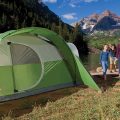
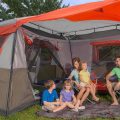





Hey there! Can you help me figure out which type of stake works on grassy fields AND on sandy beaches? I need one that works on both terrains, but I can’t find one! Please let me know if you have a recommendation 🙂